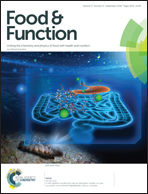Effects of oat protein supplementation on skeletal muscle damage, inflammation and performance recovery following downhill running in untrained collegiate men†
Abstract
The positive influence of animal-based protein supplementation during muscle-damaging exercise has been widely studied. However, the effects of plant-based proteins remain unclear and require further clarification. This study investigated the protective role of oat protein against exercise induced muscle damage (EIMD), subsequent inflammation, and loss of performance induced by downhill running. Subjects consumed either oat protein (25 g protein) or a placebo for 14 days prior to a downhill running test and then for 4 days thereafter. Treatments with oat protein for 19 days markedly alleviated eccentric exercise induced skeletal muscle soreness, and reduced the elevation of plasma IL-6 concentrations and serum creatine kinase, myoglobin and C reactive protein contents. In addition, oat protein supplementation significantly inhibited limb edema following damaging exercise, and the adverse effects on muscle strength, knee-joint range of motion, and vertical jump performance were lessened. Furthermore, the administration of oat protein facilitated recovery from exhaustive downhill running in this study. These findings demonstrated that oat protein supplementation has the potential to alleviate the negative effects of eccentric exercise in untrained young males.



 Please wait while we load your content...
Please wait while we load your content...